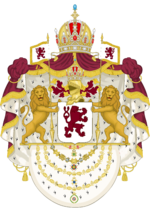Rudolphine Confederation
Rudolphine Confederation Eidgenossenschaft | |||||||
|---|---|---|---|---|---|---|---|
| 1027-1786 | |||||||
 The Rudolphine Confederation at its greatest extent prior to the Amendist Wars in 1582. | |||||||
| Capital | No single/fixed capital (1027-1640) Westbrücken (1640-1786) de jure Wiesstadt (1640-1786) de facto | ||||||
| Common languages | Official: Weranian and Medieval Solarian | ||||||
| Religion | Official: Catholicism (1106-1607) | ||||||
| Government | Confederal elective monarchy (1027-1674) Confederal absolute monarchy (1674-1785) Confederal constitutional monarchy (1785-1786) | ||||||
| Rudolphine Protector | |||||||
• 1027-1051 (first) | Rudolf I | ||||||
• 1764-1785 (last) | Leopold III | ||||||
| Legislature | Tagsatzung | ||||||
| Historical era | Middle Ages Early modern period | ||||||
• Established | 1027 | ||||||
• Disestablished | 1786 | ||||||
| Population | |||||||
• 1582 | ~8,000,000 | ||||||
• 1786 | ~20,000,000 | ||||||
| |||||||
The Rudolphine Confederation (Weranian: Eidgenossenschaft) was a historical confederation that ruled over much of north Euclea from its declaration in 1027 to the Weranian Revolution when it was replaced by the Republic of Werania in 1786. At its height it spanned across the entirity of modern day Werania, Azmara and Alsland as well as southern Scovern, northern Estmere and western Kirenia.
Th confederation was formed in 1027 by the princes of northern Weraninland to contest the Estmero-Verliquoian invasion of modern day Borland. The confederation changed over time from a predominantly pagan to mainly Catholic body. It would retain a rivalry with the Kingdom of Ruttland until the latter became part of the confederation in the Union of Trierberg in 1267 with the Ruttish King Wilhelm I becoming protector of the confederation. By the 1480s however power had shifted to the Cislanian House of Schwarzollen who would dominate the confederation from that point on.
Historically a decentralised entity the confederation was torn apart by the Amendist Wars. Following the wars the confederations leaders attempted to centralise the realm abolishing many noble privileges but this alienated many of its members. The Ten Years' War saw the confederation devastated and it entered a steep decline resulting in the Weranian revolution in 1785, which saw the confederation remoulded into the Weranian Republic a year later.
The confederation slowly evolved from being a purely military alliance to by its demise in 1785 a modern, centralised state. It tends to be percieved as a precursor to the modern Weranian state although its legacy affects all its former neighbours.


